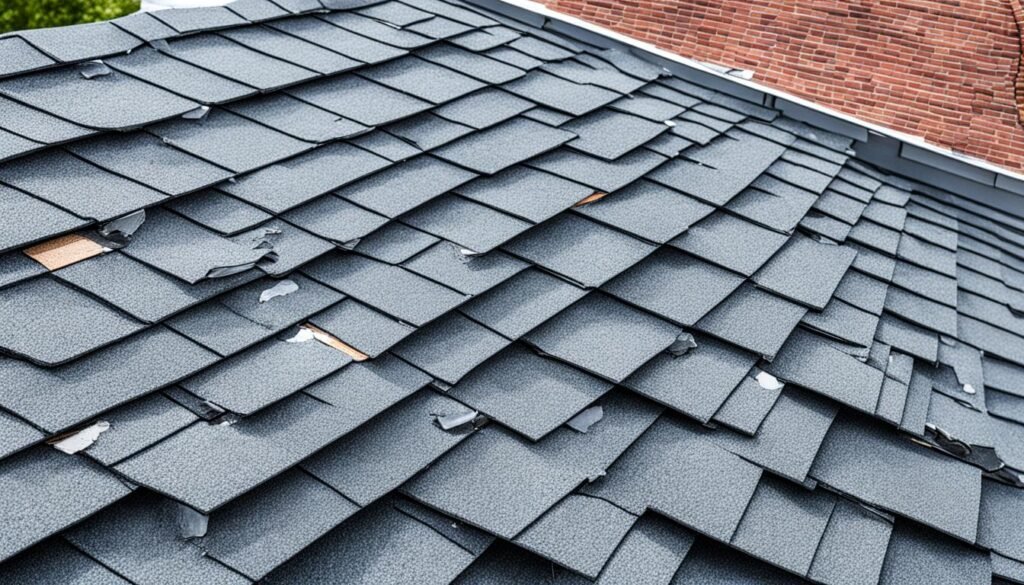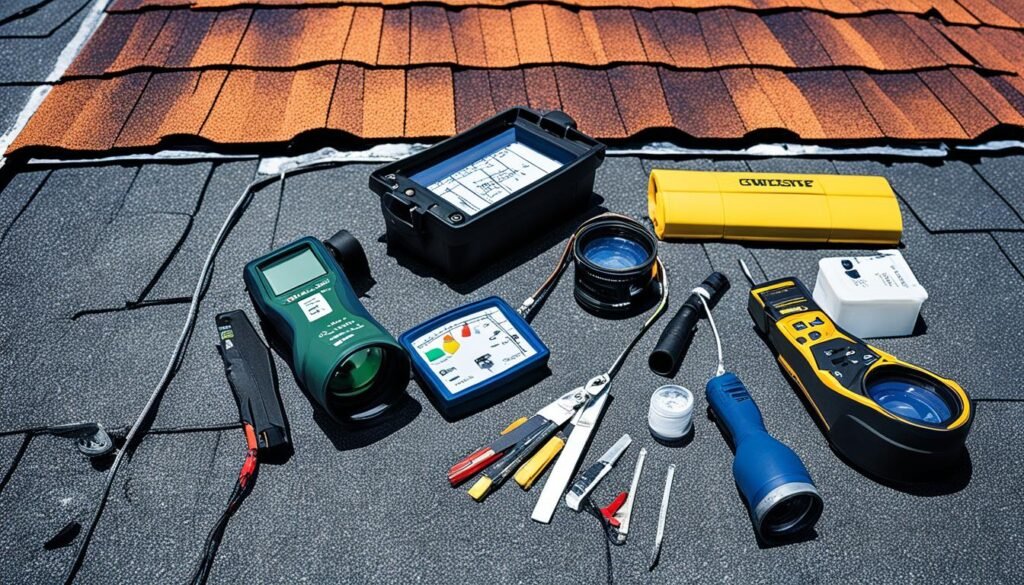Did you know that water leaks cause almost 85% of property damage in the U.S.? For homeowners, a leaky roof is a big worry. It’s not just the mess. If ignored, roof leaks can create serious water damage, lead to costly repairs, and even cause health problems like mold.
Learning how to spot and fix roof leaks quickly is crucial. By knowing the signs and using easy DIY methods, you can stop more damage. This also means avoiding high costs from things like getting rid of mold or getting a new roof.
We’ll show you easy DIY roof leak detection steps in this guide. They’re simple to do and can protect your home and your money. Whether you’ve owned homes before or you’re new to this, these steps will help you find and fix leaks before they get worse.
Key Takeaways:
- Water leaks account for nearly 85% of all property damage in the United States.
- Recognizing and addressing roof leaks early can prevent costly repairs and health hazards.
- DIY roof leak detection techniques are essential for protecting your property and wallet.
- Regular maintenance and prompt repairs can help prevent extensive water damage.
- Engaging a reliable roofing company can provide the expertise needed for complex or major roof leaks.
Common Causes of Roof Leaks
Many common causes can lead to roof leaks. Being aware of these can help homeowners take steps to prevent damage. Let’s look at some key things to keep in mind.
Damaged or Missing Shingles
Shingles protect your home from water. If they get damaged or go missing, leaks can happen. Check your roof often for any shingle problems and fix them quickly.
Cracked or Damaged Flashing
Flashing seals roof joints and edges but can crack or get damaged over time. Water can then leak through these spots. Make sure to regularly look at the flashing and repair any issues.
Rusted or Damaged Roof Vents
Roof vents help keep air moving in your attic. But if they get rusty or broken, leaks can occur. Watch for any damage and fix it right away.
Deteriorated Plumbing Vent Boots
Plumbing vent boots cover vent pipes on your roof. They can wear out or break, letting in water. Inspect these boots often and replace them when needed.
Poor Attic Ventilation
Bad ventilation in your attic can lead to too much moisture and leaks. Make sure your attic is well-ventilated to avoid these issues. If you’re unsure, ask a professional for help.
Clogged Gutters
When gutters get clogged, water can’t flow properly and might leak into your roof. Clean your gutters and downspouts regularly to prevent this problem.
Ice Dams
In colder areas, ice dams can block water from draining off your roof. This can lead to leaks. Good insulation and ventilation can stop ice dams from forming.
Improper Installation of Roofing Materials
Incorrectly installed roofing materials can leave gaps. Water can get through these gaps and cause leaks. Always use professionals for roof installation to avoid this issue.
Checking your roof regularly can help stop leaks before they get worse. By dealing with problems early, you can keep your roof in top shape and avoid big repair bills.

Common Causes of Roof Leaks
| Cause | Description |
|---|---|
| 1. Damaged or Missing Shingles | Broken, cracked, or missing shingles that allow water to penetrate. |
| 2. Cracked or Damaged Flashing | Flashing around roof joints and edges that is cracked or deteriorated. |
| 3. Rusted or Damaged Roof Vents | Roof vents that are rusted or damaged, creating openings for water infiltration. |
| 4. Deteriorated Plumbing Vent Boots | Protective covers for vent pipes that are deteriorated or loose, allowing water entry. |
| 5. Poor Attic Ventilation | Inadequate airflow in the attic leading to moisture buildup and potential leaks. |
| 6. Clogged Gutters | Gutters and downspouts clogged with debris, causing water overflow and roof leaks. |
| 7. Ice Dams | Icicles forming on the roof, preventing proper drainage and causing water backup. |
| 8. Improper Installation | Incorrect installation of roofing materials, leading to gaps and vulnerabilities. |
DIY Roof Leak Detection Methods
As a homeowner, it’s smart to detect and fix roof leaks early. This way, you can avoid costly repairs and keep your roof in top condition.
Inspecting Your Interior
Start by looking inside your home for signs of a leak. Water stains on ceilings or walls are big clues. Musty smells or bulging areas also suggest moisture problems. Catching these signs early lets you tackle leaks quickly.
Evaluating Your Roof’s Surface
Next, check your roof’s exterior. Keep an eye out for damaged shingles, missing nails, or any cracks. These issues could let water in. Finding and fixing them can stop leaks from getting worse.
Conducting a Hose Test
If you’re unsure where a leak is, try the hose test. Have someone inside watch as you run water over the roof with a garden hose. This helps find the leak’s exact spot so you can fix it right.
Utilizing Smoke or Incense
Using smoke or incense can also find leaks. In your attic, light incense or use a smoke machine. Notice how the smoke moves. If it gets sucked out or disturbed, you’ve likely found a leak.
Regular Maintenance
Regular upkeep can prevent leaks. Clean gutters to avoid water build-up on your roof. Ensure the flashing around vents and skylights is undamaged. Cut back any tree branches that could harm your roof in storms.
| DIY Roof Leak Detection Tools | Fixing Roof Leaks at Home | Roof Leak Prevention Tips |
|---|---|---|
| Inspection of interior for water damage | Inspecting the roof’s surface for shingle damage | Regular maintenance of gutters and flashing |
| Hose test to pinpoint leak location | Utilizing smoke or incense in the attic | Trimming overhanging branches and vegetation |

Using these DIY methods, you can protect your home from roof leaks. Yet, for big or complex leaks, hiring a pro roofer is best. They have the skills and tools for proper repair. Remember, finding and preventing leaks early is key to a strong, leak-free roof.
Conclusion
Understanding how to spot roof leaks is key for homeowners. This protects your property from water damage. Checking your roof often and trying DIY methods helps you tackle issues early. But, remember, for big or complex leaks, getting professional help is best. This ensures your roof is properly fixed and stays in good shape.
For roof leak repairs and to avoid future issues, consider hiring Local Roofer Pros. They have the skills, tools, and quality service needed. They’ll help you fix roof leaks well. Don’t wait to call them for quick and reliable help.
Using preventive actions and fixing roof leaks early saves you money on big repairs later. Follow these tips to keep your roof safe and dry. Taking steps now keeps your home protected.
